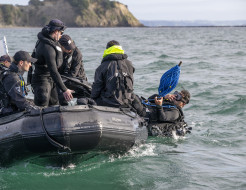
Navy divers neutralise Second World War mines in Hauraki Gulf
26 June 2025
Unfortunately you are viewing this website on an outdated browser which does not support the necessary features for us to provide an adequate experience. Please switch to a modern browser such as latest version of Google Chrome, Mozilla Firefox, Apple Safari or Microsoft Edge.
Ngā mihi nui
Living in peaceful times doesn’t just mean being peaceful within our homes, land, and country. We are a Pacific Island nation, surrounded by water. To protect our country beyond dry ground, we need a Navy.
We sometimes refer to ourselves as a ‘large oceanic nation’ because New Zealand’s interests and territory extend further than the coastline – which, as it happens, is the ninth longest in the world. New Zealand’s Exclusive Economic Zone, sitting 200 nautical miles out from New Zealand, is approximately 15 times our land area and is one of the largest EEZs in the world.
And beyond, we have responsibilities towards the Cook Islands, Niue and Tokelau. We also have a sector of Antarctica, the Ross Dependency, for which we maintain an interest under the Antarctic Treaty of 1961.
But the New Zealand Defence Force, and its Navy, projects itself wider than that. Peace and security isn’t something that one country handles alone. We partner with other countries, such as Australia, the United Kingdom, the United States and Canada, to promote global peace and security. Globally, there are more challenges. Different countries around the world are pursuing goals that are threats to peace. There are people who pursue extreme ideologies. Organised crime is international. Countries like New Zealand are stronger when we work with other countries to promote peace and security.
We protect the world-wide concept of free passage, free trade and freedom of navigation because New Zealand – and many other nations - are so dependent on these concepts. Most of our country’s exports (90 per cent) and most of its imports are transported by the sea. We are vulnerable to anything that affects maritime trade, and we need to protect it.
Our Navy has responded to calls for help when other countries are having conflicts. Navy personnel take part in peacekeeping operations around the world. Naval vessels and people have been deployed to East Timor, Solomon Islands, Sudan, the Middle East, the Korean Peninsula and Afghanistan.
Our frigates have deployed to the Indian Ocean, Arabian Gulf and the Horn of Africa to help protect trade routes and prevent piracy and terrorism.
Closer to home, our Navy vessels conduct regular border and resource protection patrols supporting Customs and Ministry for Primary Industries, Search and Rescue operations, as well as supporting other agencies including the New Zealand Police, the National Emergency Management Agency, and Department of Conservation.
Our Inshore Patrol Vessels work around the New Zealand coast and two Offshore Patrol Vessels conduct similar work in the Southern Ocean and the South Pacific.
These area some of our stories
Our other areas of work